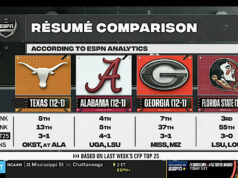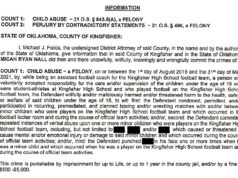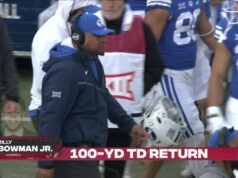On the first play of its annual spring game in April 1999, the Oklahoma Sooners football team lined up in a familiar way: a wishbone formation.
Every play after that, however, was incredibly unfamiliar: several wide receivers, wide offensive line splits and an incredibly wide-open offense. It was the dawn of the air raid offensive era, both at OU and for college football as a whole, and one man directed the show.
Welcome to the Sooners, Mike Leach. Nothing would be the same again.
Leach, 61, died in the early morning hours of Dec. 13 following a heart attack. He left behind a sport changed by his presence, but also a blue-blood college football program molded into his image of what the sport should be.
A remarkable Sooner switch
Going into the 1999 season, OU was coming off five straight non-winning seasons. During those years, OU’s offense could best be described as constipated. While OU’s defense had its ups and downs from 1994 to 1998, it was a bastion of stability compared to the post-Cale Gundy-led offenses of the period.
Garrick McGee, Eric Moore, Justin Fuente, Patrick Fletcher, Jake Sills and Brandon Daniels were among the parade of signal-callers who lined up under center after Gundy’s graduation. None covered himself with laurels, and, consequently, neither did their offenses.
The year before new head coach Bob Stoops hired Leach as offensive coordinator, OU finished 11th out of 12 conference teams in total offense.
The next year, with Leach calling plays, the Sooners finished as the top Big 12 team in total offense.
Voila.
After a half-decade of offensive ineptitude, Leach more than fixed the problem in just a few months on campus in Norman. He made the problem a team strength.
Leach made more than just a single-season impact. He changed the offensive culture at OU and set forth a new lineage of wide-open offenses. Before Leach’s arrival, OU football was known for staunch defenses and Earth-tethered offensive schemes, such as the aforementioned wishbone. After Leach brought his air raid to Norman in 1999, the Sooners have been synonymous with high-flying attacks led by Heisman Trophy-contending quarterbacks.
Leaving, and leaving his mark
Leach’s stay with OU was truncated to only a single season, and for good reason. When you fix the offensive ills of an ailing football power like Oklahoma so quickly, other programs will come calling for your services. Texas Tech hired Leach in December 1999, and his Red Raider teams attacked OU with the same wide-open offense for the next decade.
Still, Mike Leach’s impact with the Sooners continues today. Even the offense OU ran this season owes far more to Mike Leach than to Barry Switzer. Wide receivers trying to space the defense laterally and downfield remains much more popular than running backs taking backward pitches from a quarterback crouched under center.
The days of “three yards and a cloud of dust” are long gone for the crimson and cream. Instead, OU’s quarterbacks often throw 30, 40, 50 or even 60 passes a game. In a 2013 win against Oklahoma State, for example, Sooners quarterback Landry Jones chucked an OU-record 71 passes.
Flawed and odd
Leach was not a perfect coach by any stretch of the imagination. His wide-open, tight end-less offenses didn’t exactly make a good practice partner for his teams’ defenses, and, consequently, stopping his opponents’ offenses became nearly as big a problem as it was for opponents to stop his. Meanwhile, the rest of college football became familiar with the air raid, and Leach’s talent pool declined at his subsequent coaching stints at Washington State and Mississippi State.
While Leach’s idiosyncratic personality proved hilarious in a press conference, it could be a turn-off to the starched suits who largely run college athletics departments. The brass at Texas Tech had obviously tired of his oddball behavior, which influenced why he was so quickly and easily fired from the Red Raiders on the basis of what seemed to be specious accusations of player mistreatment. He never could get a job that was considered more than an outpost in the world of college football. While he made his teams nationally relevant in Lubbock, Pullman and Starkville, nobody from Ann Arbor, Columbus, Los Angeles, Lincoln, Austin or Athens ever feigned interest in his services.
It wasn’t always quirky fun with Leach, either. He had a habit of calling out his own players, not in a locker room, but instead behind a podium in a press conference setting. After his Mississippi State team lost a game in which it missed three field goals, he infamously announced after the game he was going to have open tryouts for a new kicker.
A curious iconoclast
Those foibles should not overshadow Mike Leach’s accomplishments or impact on the game and his players. In my mind, they just prove that Leach was not a perfect person or coach, much like the rest of us.
Describing college football coaches as myopic can be akin to calling the Grand Canyon a large ditch, but I viewed Leach as wonderfully iconoclastic. He wrote a book about Geronimo. He taught college courses on military strategy. He had a law degree and could report the weather in a pinch. He strongly advised others — during a football press conference, of all places — to not pet a buffalo. He once followed raccoon tracks in the snow for a half-mile, simply because he was “curious where this sucker lived.”
People wiser than me have offered the advice — further immortalized by fictional coach Ted Lasso — to be curious, not judgmental. Leach obviously lived by those words.
Still making noise in Norman
Long after Mike Leach left Norman, his impact continued to be felt by the Sooners. In 2014, after a mediocre 8-5 season that saw OU’s offense falter a bit, but still average a solid 464.7 yards per game, Stoops publicly declared he felt his team had strayed too far away from the air raid offense of Mike Leach. He immediately hired Leach disciple Lincoln Riley as offensive coordinator.
The next year saw the Sooners post an 11-2 mark, win a conference championship and receive a berth in the College Football Playoff, while averaging an eye-popping 530.2 yards per game.
Over the next six years with Riley as offensive coordinator and, eventually, head coach, the Sooners never fell out of the top 10 in the country in total offense, all while following the essential tenets of Leach’s offense more closely.
While processing his death this week, it dawned on me that I have always felt Mike Leach imprinted his mark upon the OU fanbase as well. Walking beneath the stands following the season-opening win against UTEP in 2000 — the first season after Leach had left OU — I noticed a discarded noisemaker, shaped like a dog’s bone with the term “air-bone” printed on it.
I laughed as I studied the curious piece of plastic. How quick we, as fans, are to embrace any evolution if it means victories and fun times at the ol’ stadium. Essentially, in my mind, the noisemaker echoed the Sooners’ 1999 spring game gesture to the program’s past wishbone teams: a nod to the past, but a need to make noise in the present and future.
I would like to think that a small bit of Mike Leach’s noise will still ring through the stadium every time the Sooners complete a big pass on an autumn Saturday night.





















